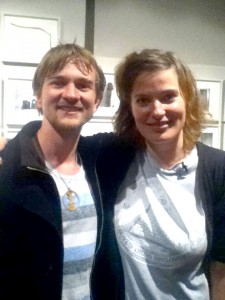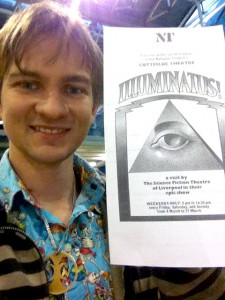
Brenton Clutterbuck
Here’s a hint of what went down in London.
—Brenton Clutterbuck
We’ve reached part two of the Chasing Eris adventure. I’ve taken my accommodation in Bristol, a city full of artistic energy, close to my intended interviewees. On one of my first days in the city, I jump on a train to London.
There are two great stories of Discordia waiting to be told here. One is of The KLF, the superstar band that took the world by storm, before quitting the music business and burning a million pounds of cash. The starting point of that first story grows out of the fertile, imaginative ground of our second story—the Illuminatus! Play of November 23, 1976.
Robert Anton Wilson first discovered Discordianism through his mail correspondence with Kerry Thornley in 1967. In a 1992 interview with Reverend Wyrdsli, Thornley discussed Wilson’s interest in Discordia:
He said, very early in our relationship that one of the things we needed were God models that were appropriate to anarchism. And he had written some stuff about Taoism and the spirit of the Valley Lady: the eternal female, and about Shang Dynasty matrism and so on and so forth. So I suggested to him Eris Discordia and told him about the Discordian Society, and he was just very enthused about it, plunged into it, got very active in it, and was responsible for a lot of our creeds and dogmas and so on and so forth.
Robert Anton Wilson would become involved in Operation Mindfuck that next year, participating in various Discordian shenanigans, including the development of a large mythos built-up around the Bavarian Illuminati. This mythos would appear to have gone on to influence the modern pop-cultural idea of the Illuminati, from books such as Umberto Eco’s conspiracy classic Foucault’s Pendulum (Amazon) to the pop-culture runaway successes of Dan Brown’s novels The Da Vinci Code (Amazon) and Angels and Demons (Amazon), and the film adaptation of Lara Croft: Tomb Raider (Amazon Instant Video), though Wilson’s influence is seldom credited.
Robert Shea, the editor of anarchist zine No Governor was Wilson’s partner in crime. The pair were working together editing the Playboy Forum letters section. A number of the letters they received were from paranoids (or most likely letters Shea & Wilson planted), alleging that they were the target of various conspiracies. Using the concept that perhaps every single one of the alleged conspiracies was true, they began work on the Illuminatus! Trilogy (Amazon).
One of the plot devices of Illuminatus! was that it featured a long-running feud between the Discordians and the Illuminati. This was a theme that had previously been carried through a number of Discordian writings in the zine scene, and was invoked in the Illuminatus! Trilogy at Shea’s suggestion.
The first volume of Illuminatus! was released in 1975, and did a great deal to popularize Discordianism. Readers mistakenly assumed the mysterious Principia Discordia mentioned in Illuminatus! was one of the many fabrications of Shea and Wilson, and were later often stunned to learn the Principia Discordia was, in fact, real.

Ken Campbell's daughter,
Daisy Eris Campbell. Check out
her production of
RAW's Cosmic Trigger.
Courtesy of Brenton Cluttberuck.
As a result, Illuminatus! became the first project to be performed in Liverpool Theatre of Language, Music, Dream and Pun.
Anyone who has seen a copy of Illuminatus! has had the sheer size of the work impressed upon them. Completing it is no mean feat. Adapting it down to the size of a typical play would be an even more daunting feat. However Campbell took it a step further; instead of cutting out huge chunks of the text he kept the work at largely its original size, and developed eight-and-a-half hours of performance. In Liverpool he presented five plays over five nights, with the fifth being a presentation of all five; one after the other in a mammoth all day performance.
The creative team behind the play included Chris Langham—who helped produce the play alongside Campbell—as lead role George Dorn, Jim Broadbent in a number of minor roles including biological weapon designer Dr. Charles Moncenigo and the sadistic Sheriff Jim Cartwright, Bill Nighy as magazine editor Joe Malik, David Rappaport as Markoff Chainey, and the work of Bill Drummond, later of The KLF fame, as a set designer.
I walked up to the National Theatre. After the Liverpool shows the play moved on to performances in Amsterdam, before finally coming to London. I had come here just to stand in front of the theatre and do a small video talking about the play, but thought I’d try my luck wandering on in and asking at the theatre shop if they knew anything about the Trilogy. They referred me to the National Theatre Archive which, in my ignorance, I had not known about.

I pulled out several newspaper articles. Most were reviews, but a small number stood out in particular as bizarre oddities that contributed an additional layer of weirdness to the already larger than life Illuminatus! saga.
One article was titled “Horror Mission of an Actor Obsessed with the Occult” from the Daily Mail, dated September 7, 1982 about Illuminatus! cast member Chris Taynton whose roles included the pimp Carmel and Robert Putney Drake, the head of the American Crime Syndicate. The article told of how Taynton, believing he had been overcome by alien forces, attacked Adrena Smith, a 57-year-old lady, by stabbing her multiple times. He blinded her in one eye, and killed her pets, including cutting the ears off her dog. Taynton’s involvement in the Illuminatus! play was raised in court by his defense lawyer, Patricia May, specifically in regard to the play’s supernatural and occult themes.
“Having taken an extremely exciting part in a somewhat bizarre play he became more and more involved in the principles that were propounded in that play,” said May.
It seems a number of the cast went on to have troubled futures. David Rappaport, a dwarf actor, who also played a main role in Terry Gilliam’s movie Time Bandits (Amazon Instant Video), struggled with depression in his later life and ended up shooting himself fatally in the chest in 1990, in Laurel Canyon Park, California.
Chris Langham too was jailed for 10 months in 2007 for possessing Level Five child pornography, which he claimed was both part of researching a character and helping himself deal with his own abuse as an eight year old child.
Before we enter into The Curse of Tutankhamen territory, it’s worth noting not all actors in Illuminatus! had such tragic futures waiting for them. Jim Broadbent and Bill Nighy continue to enjoy prosperous acting careers, and Ken Campbell left a legacy of genius (as well as a record for longest play ever—not in fact for Illuminatus!—but for his 22-hour long The Warp). He was remembered by Liverpool Everyman Theatre and Playhouse Artistic Director Gemma Bodinetz as “The door through which many hundreds of kindred souls entered a madder, braver, brighter, funnier and more complex universe.”
Another, less ghoulish article I read was titled “Raising School Fees for Gorilla,” and was published in The Guardian on April 19, 1977.
In Illuminatus!, our intrepid heroes encounter a group of gorillas. Hagbard Celine, played by Neil Cunningham, has a conversation with them in Swahili (the gorillas all speak English, but are much more comfortable with Swahili). When Malik (Bill Nighy) asks if Celine taught the gorillas to speak, he responds that the gorillas have always been able to speak, but have largely kept their abilities secret:
“…the gorillas themselves are too shrewd to talk to anybody but another anarchist. They’re all anarchists themselves, you know, and they have a very healthy wariness about people in general and government people in particular. As one of them told me once, ‘If it got out that we can talk, the conservatives would exterminate most of us and make the rest pay rent to live on our own land; and the liberals would try to train us to be engine-lathe operators. Who the fuck wants to operate an engine lathe?’ They prefer their own pastoral and Eristic ways, and I, for one, would never interfere with them.”
Meanwhile in the “real” world at Stanford University, apparently unaware of the gorillas’ long term bluff, Miss Penny Patterson was busy trying to teach English to Koko the Gorilla.
Koko, according to the book Drawing the Line: Science and the Case for Animal Rights (Amazon), knew 2000 spoken English words and 1000 words in American Sign Language as of 2003. However, in 1977, the project was in very real danger of running out of money, the result to be that Koko would find herself returned to the San Francisco Zoo.
Perhaps because of the plot connection, or perhaps for other more incomprehensible and possibly synchronistic reasons, the Science Fiction Theatre of Liverpool (the organization run by Campbell and Langham specifically to produce the play) decided to support the project, even going as far as to consider adding an optional 50p levy to the audience in addition to setting up a stall to raise money.
“It was exactly the sort of research we think should be continued,” said Nighy.
“You never know what might be found out,” Campbell was quoted as saying.
The complete version of this article will appear in my forthcoming book Chasing Eris.